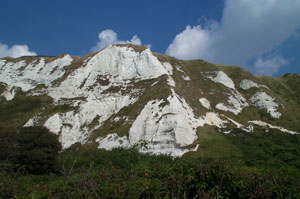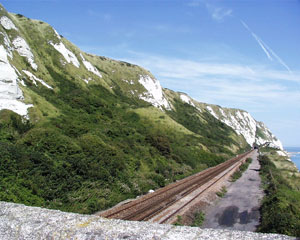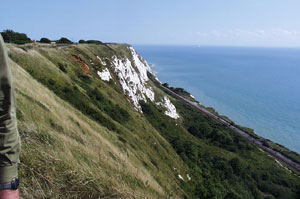The Folkestone Warren landslide is a very large, deep-seated coastal landslide that is well known to geologists and engineers. It is about 3 km wide and up to 350 m in length. There are nine surveys in the BGS National Landslide Database: IDs 1774/1 to 1774/9.
The village of Capel-le-Ferne is situated behind the landslide at the cliff top and the wide undercliff is given over to a country park.

Folkestone Warren location map. BGS © UKRI.
The Dover to London mainline railway (via Cheriton) passes through the entire length of the Warren, with the Abbotscliff Tunnel at the eastern end and the Martello Tunnel at the western end. Since its construction, the railway has been regularly disrupted by landslide activity and considerable expenditure has been, and continues to be, involved in remediation and monitoring. The old Dover road is situated close to the cliff edge. This has also been disrupted, and re-routed in parts, for the same reason.
The geology of the platform at beach level varies along the length of the Warren. At the eastern end, the platform changes from Gault Formation to chalk. The change occurs approximately in line with the eastern end of the concrete toe-weight apron (constructed in 1953), near Horsehead Point. Rock revetment has been placed to the east of the concrete apron by Network Rail. It is notable that, westward of Horsehead Point, the platform is displaced seaward by about 50 m due to movements of the various slide masses (Trenter and Warren, 1996).

Figure 1 The Folkestone Warren Landslide (Photograph taken September 2002)
Geology
The geology consists of the White and Grey Chalk subgroups overlying the Gault Formation and the Folkestone Formation, the principal slide surface being located at the Gault/Folkestone junction.
The upper part of the chalk sequence here is the White Chalk Subgroup comprising, from top to bottom, the New Pit Chalk Formation resting on the Holywell Nodular Chalk Formation.
The lower part of the chalk sequence is the Grey Chalk Subgroup, formed by the Zig Zag Chalk Formation resting on the West Melbury Marly Chalk Formation. Superficial deposits forming the Clay-with-Flints Formation overlie the chalk.
Beneath the chalk sequence lies the Gault Formation, with the thin ‘Chloritic Marl’ bed at their junction. The Gault Formation consists of between 44 and 48 m of overconsolidated clay. Beneath the Gault Formation is the Folkestone Formation of the Lower Greensand Group, with the ‘Sulphur Band’ at their junction. The Folkestone Formation consists of calcareous and glauconitic sands and sandstones with some argillaceous horizons (Trenter and Warren, 1996).
Landslide
The Folkestone Warren landslide is one of the largest on the English coast and is a classical example of a deep-seated (approximately 40 m below sea level) multiple retrogressive, compound mechanism, having translational, rotational and graben (sunken block) features.
The Folkestone Warren cliffs are divided into the chalk ‘High Cliff’, essentially the overall landslide backscarp, and the sea ‘cliff’, consisting largely of landslipped material. The High Cliff as such is not directly influenced by the sea, unlike the Folkestone Warren landslide as a whole.
The landslide has been extensively studied since 1915, when a major re-activation occurred throughout the complex seriously disrupting the railway that was constructed in 1844 (Hutchinson, 1969; Hutchinson et al., 1980; Trenter and Warren, 1996; Warren and Palmer, 2000). Included in this event were chalk slides from the High Cliff, in particular the ‘Great Fall’ landslide. Hutchinson et al. (1980) describes the three dominant subvertical joint sets within the chalk and their influence on the form of the High Cliff and on landslides within it. In recent decade,s a large amount of instrumentation and remedial works has been installed and maintained by Network Rail within the Warren.

Massive rotational failure in 1915 affecting the Folkestone to Dover train (British Railways, Southern Region).
The age of the original landslide event is not known. Most landslide movements in recent times have been confined to the undercliff in the form of re-activations of existing, deep-seated landslide masses. However, numerous significant slope failures of the High Cliff are believed to have occurred since the 1800s.
As part of a programme of work monitoring coastal erosion and landsliding at several sites around the coast of Great Britain, BGS has surveyed the Folkestone Warren landslide complex with LiDAR.
Gallery

The Folkestone Warren Landslide. BGS © UKRI (taken September 2002).

Folkestone Warren cliffs. BGS © UKRI.

Folkestone Warren cliffs. BGS © UKRI.

Folkestone Warren cliffs. BGS © UKRI.

Folkestone Warren cliffs. BGS © UKRI.

Folkestone Warren cliffs. BGS © UKRI.

Folkestone Warren cliffs. BGS © UKRI.

Folkestone Warren cliffs. BGS © UKRI.

Folkestone Warren cliffs. BGS © UKRI.

Folkestone Warren from railway bridge. BGS © UKRI.

Folkestone Warren landslide (east). BGS © UKRI.
More information
Hutchinson, J N. 1969. A reconsideration of the coastal landslides at Folkestone Warren, Kent. Géotechnique, Vol. 19(1), 6–38.
Hutchinson, J N, Bromhead, E N, and Lupini J F. 1980. Additional observations on the Folkestone Warren landslides. Quarterly Journal of Engineering Geology & Hydrogeology, Vol. 13(1), 1–31. DOI: https://doi.org/10.1144/GSL.QJEG.1980.013.01.01
Trenter, N A, and Warren, C D. 1996. Further investigations at the Folkestone Warren landslide. Géotechnique, Vol. 46(4), 589–620.
Warren, C D, and Palmer, M J. 2000. Observations on the nature of landslipped strata, Folkestone Warren, United Kingdom. Proceedings of the 8th International Symposium on Landslides, Cardiff, June 2000.
Acland, C L. 1869. The late landslip on the Warren. Quarterly Journal of the Folkestone Natural History Society, Vol. 3, 48–51.
Arber, M A. 1940. The coastal landslips of south-east Devon. Proceedings of the Geologists’ Association, Vol. 51, 257–271.
Barton, M E, and McCosker, A M. 2000. Inclinometer and tiltmeter monitoring of a high chalk cliff. 127–132 in Landslides in Research, Theory and Practice. (Bromhead, E, Dixon, N, and Ibsen, M-L (editors). (London, UK: Thomas Telford.)
Bell, F G, Cripps, J C, Edmonds, C N, and Culshaw, M G. 1990. Chalk fabric and its relation to certain geotechnical properties. 187–193 in Chalk.
Bishop, C H. 1973. Folkestone: The Story of a Town. (London and Ashford, UK: Headley Brothers Ltd.)
Bromhead, E N, Hopperm A C, and Ibsen, M-L. 1998. Landslides in the Lower Greensand escarpment in south Kent. Bulletin of Engineering Geology and the Environment, Vol. 57(2), 131–144.
Bromhead, E N, and Ibsen, M-L. 2004. Bedding-controlled coastal landslides in Southeast Britain between Axmouth and the Thames Estuary. Landslides, Vol. 1, 131–141.
Drew, F. 1864. The geology of the country between Folkestone and Rye, including the whole of Romney Marsh. Memoir of the Geological Survey of Great Britain. (London, UK: HMSO.)
Folkestone Chronicle, 10 December, 1859.
Folkestone Chronicle, 11 February 1856.
Folkestone Chronicle, 20 January 1877.
Gentleman’s Magazine. 1806. Country News (June). Vol. 76, 575.
Haselock, P J, and Gale, A R. 1998. The Folkestone Warren landslip: a model for the decay of fault scarps? Proceedings of the 19th Annual Meeting of the Tectonic Studies Group.
Hutchinson, J N. 1965. A survey of coastal landslides in Kent. Building Research Station Note No 35/36.
Hutchinson, J N. 1986. Cliffs and shores in cohesive materials; geotechnical and engineering geological aspects. 1–44 in Proceedings of the Symposium on Cohesive Shores, 5–7 May 1986 Burlington, Ontario. Skafel, M G (editor).
May, V J. 1964. A study of recent coastal changes in southern England. MSc thesis (unpublished) University of Southampton.
McDakin, J G. 1900. Coast Erosion: Dover Cliffs.
McDakin, J G. 1911. Abbotscliff (Warren) Chalkfall Geological Notes. East Kent Scientific and Natural History Society Reports and Transactions, Vol. 16, 15.
McGowan, A, Roberts, A G, and Woodrow, L K R. 1988. Geotechnical and planning aspects of coastal landslides in the United Kingdom. In: Landslides Glissements de Terrain. Bonnard, C (editor). Vol. 2.
Morgenstern, N R, and Price, V E. 1965. The analysis of the stability of general slip surfaces. Géotechnique, Vol. 15, 79–93.
Muirwood, A M. 1971. Engineering aspects of coastal landslides. Proceedings of the Institution of Civil Engineers, Vol. 50, 257–276.
Osman, C W. 1917. The landslips of Folkestone Warren and thickness of the Lower Chalk and Gault near Dover. Proceedings of the Geologists’ Association, Vol. 28, 59–84.
Phillips, W. 1821. Remarks on the Chalk cliffs in the neighbourhood of Dover, and on the Blue Marls covering Green Sand near Folkestone. Transactions of the Geological Society, Vol. 5, 16–46.
Price, F G H. 1877. On the beds between the Gault and Upper Chalk near Folkestone. Quarterly Journal of the Geological Society, Vol. 33, 431–448.
The Railway Magazine. 1919. Railway landslides: engineering problems at Wembley and the Warren. July issue, 45: 23–31.
The Times, 14 December 1859, page 12.
Toms, A H. 1946. Folkestone Warren landslips: research carried out in 1939 by the Southern Railway Company. Institute of Civil Engineers, Railway Paper No. 19.
Topley, W. 1893. The landslip at Sandgate. Proceedings of the Geologists’ Association, Vol. 13(2), 40–47.
Viner-Brady, N E V. 1955. Folkestone Warren landslips: remedial measures 1948–1954. Proceedings of the Institution of Civil Engineers, Vol. 4(3), 429–441.
Wood, M. M. (1955), Folkestone Warren landslips: investigations 1948–1950. Proceedings of the Institution of Civil Engineers, Vol. 4(3), 410–428.
You may also be interested in

Landslide case studies
The landslides team at the BGS has studied numerous landslides. This work informs our geological maps, memoirs and sheet explanations and provides data for our National Landslide Database, which underpins much of our research.

Understanding landslides
What is a landslide? Why do landslides happen? How to classify a landslide. Landslides in the UK and around the world.

How to classify a landslide
Landslides are classified by their type of movement. The four main types of movement are falls, topples, slides and flows.

Landslides in the UK and around the world
Landslides in the UK, around the world and under the sea.


